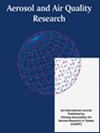Omicron Positivity in Air of Hospital Settings Gathered COVID-19 Patients, Vaccinated/Unvaccinated Populations
IF 2.5
4区 环境科学与生态学
Q3 ENVIRONMENTAL SCIENCES
引用次数: 0
Abstract
The Omicron variant spreads quicker than the earlier variants and can evade the immune response. The behavior changes and waning immunity could cause large numbers of COVID-19 infections and potential hospitalizations. Here, we present a cross-sectional/longitudinal study conducted in a tertiary hospital in Istanbul. In the cross-sectional part, we collected aerosol samples from clinical and public areas in the hospital. We performed qPCR and viral culture. In the pediatrics, outpatient clinic waiting room, where the children were without masks, and unvaccinated, 66% of the samples were positive for viral RNA. However, the positivity rate was 14% in the staff dining hall where everybody was without masks but fully vaccinated. The viral RNA was positive in 50% of the COVID-19 patient rooms, 33% of the febrile disease outpatient clinic, and 33% of the clinical laboratory waiting room. There was no viral growth in the culture of all samples. The highest viral load was detected in the COVID-19 patient room (3.60 × 10 10 PFU m –3 ), followed by the pediatrics outpatient clinic waiting room (2.8 × 10 8 PFU m –3 ). In the longitudinal study, samples were collected 0, 2.5, 4.5, and 24 hours after a meeting in which all attendees were wearing masks and three participants were diagnosed with COVID-19. Only one sample collected 24 hours after the meeting was weakly positive for the viral RNA (1.12 × 10 2 PFU m –3 ). In conclusion, mask use and vaccination are still the main effective methods for preventing the COVID-19 Omicron variant in indoor environments. Unvaccinated children are a significant source of air contamination and risk further transmission of COVID-19.医院环境中聚集的COVID-19患者、接种疫苗/未接种疫苗人群的空气组粒阳性
欧米克隆变异比之前的变异传播得更快,可以逃避免疫反应。行为改变和免疫力下降可能导致大量COVID-19感染和潜在的住院治疗。在这里,我们提出了横断面/纵向研究在伊斯坦布尔的三级医院进行。在横断面部分,我们从医院的临床和公共区域收集气溶胶样本。我们进行了qPCR和病毒培养。在儿科门诊候诊室,孩子们没有戴口罩,也没有接种疫苗,66%的样本病毒RNA呈阳性。然而,在员工食堂,每个人都没有戴口罩,但都接种了疫苗,阳性率为14%。50%的COVID-19病房、33%的发热门诊和33%的临床实验室候诊室病毒RNA阳性。在所有样本的培养中都没有病毒生长。病毒载量最高的是病房(3.60 × 10 10 PFU m -3),其次是儿科门诊候诊室(2.8 × 10 8 PFU m -3)。在纵向研究中,在会议结束后0、2.5、4.5和24小时收集样本,所有与会者都戴着口罩,三名参与者被诊断出患有COVID-19。会议后24小时采集的样本中只有一个病毒RNA呈弱阳性(1.12 × 10 2 PFU m -3)。综上所述,在室内环境中,使用口罩和接种疫苗仍然是预防COVID-19欧米克隆变异的主要有效方法。未接种疫苗的儿童是空气污染的重要来源,有进一步传播COVID-19的风险。
本文章由计算机程序翻译,如有差异,请以英文原文为准。
求助全文
约1分钟内获得全文
求助全文
来源期刊

Aerosol and Air Quality Research
ENVIRONMENTAL SCIENCES-
CiteScore
8.30
自引率
10.00%
发文量
163
审稿时长
3 months
期刊介绍:
The international journal of Aerosol and Air Quality Research (AAQR) covers all aspects of aerosol science and technology, atmospheric science and air quality related issues. It encompasses a multi-disciplinary field, including:
- Aerosol, air quality, atmospheric chemistry and global change;
- Air toxics (hazardous air pollutants (HAPs), persistent organic pollutants (POPs)) - Sources, control, transport and fate, human exposure;
- Nanoparticle and nanotechnology;
- Sources, combustion, thermal decomposition, emission, properties, behavior, formation, transport, deposition, measurement and analysis;
- Effects on the environments;
- Air quality and human health;
- Bioaerosols;
- Indoor air quality;
- Energy and air pollution;
- Pollution control technologies;
- Invention and improvement of sampling instruments and technologies;
- Optical/radiative properties and remote sensing;
- Carbon dioxide emission, capture, storage and utilization; novel methods for the reduction of carbon dioxide emission;
- Other topics related to aerosol and air quality.
 求助内容:
求助内容: 应助结果提醒方式:
应助结果提醒方式:


